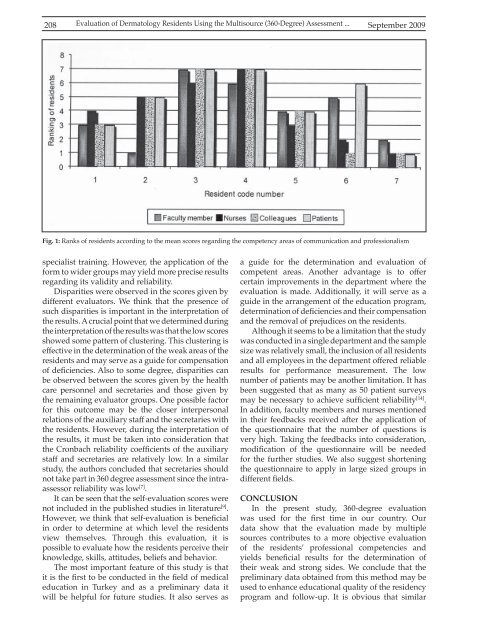Vol 41 # 3 September 2009 - Kma.org.kw
Vol 41 # 3 September 2009 - Kma.org.kw
Vol 41 # 3 September 2009 - Kma.org.kw
You also want an ePaper? Increase the reach of your titles
YUMPU automatically turns print PDFs into web optimized ePapers that Google loves.
208<br />
Evaluation of Dermatology Residents Using the Multisource (360-Degree) Assessment ...<br />
<strong>September</strong> <strong>2009</strong><br />
Fig. 1: Ranks of residents according to the mean scores regarding the competency areas of communication and professionalism<br />
specialist training. However, the application of the<br />
form to wider groups may yield more precise results<br />
regarding its validity and reliability.<br />
Disparities were observed in the scores given by<br />
different evaluators. We think that the presence of<br />
such disparities is important in the interpretation of<br />
the results. A crucial point that we determined during<br />
the interpretation of the results was that the low scores<br />
showed some pattern of clustering. This clustering is<br />
effective in the determination of the weak areas of the<br />
residents and may serve as a guide for compensation<br />
of deficiencies. Also to some degree, disparities can<br />
be observed between the scores given by the health<br />
care personnel and secretaries and those given by<br />
the remaining evaluator groups. One possible factor<br />
for this outcome may be the closer interpersonal<br />
relations of the auxiliary staff and the secretaries with<br />
the residents. However, during the interpretation of<br />
the results, it must be taken into consideration that<br />
the Cronbach reliability coefficients of the auxiliary<br />
staff and secretaries are relatively low. In a similar<br />
study, the authors concluded that secretaries should<br />
not take part in 360 degree assessment since the intraassessor<br />
reliability was low [7] .<br />
It can be seen that the self-evaluation scores were<br />
not included in the published studies in literature [9] .<br />
However, we think that self-evaluation is beneficial<br />
in order to determine at which level the residents<br />
view themselves. Through this evaluation, it is<br />
possible to evaluate how the residents perceive their<br />
knowledge, skills, attitudes, beliefs and behavior.<br />
The most important feature of this study is that<br />
it is the first to be conducted in the field of medical<br />
education in Turkey and as a preliminary data it<br />
will be helpful for future studies. It also serves as<br />
a guide for the determination and evaluation of<br />
competent areas. Another advantage is to offer<br />
certain improvements in the department where the<br />
evaluation is made. Additionally, it will serve as a<br />
guide in the arrangement of the education program,<br />
determination of deficiencies and their compensation<br />
and the removal of prejudices on the residents.<br />
Although it seems to be a limitation that the study<br />
was conducted in a single department and the sample<br />
size was relatively small, the inclusion of all residents<br />
and all employees in the department offered reliable<br />
results for performance measurement. The low<br />
number of patients may be another limitation. It has<br />
been suggested that as many as 50 patient surveys<br />
may be necessary to achieve sufficient reliability [14] .<br />
In addition, faculty members and nurses mentioned<br />
in their feedbacks received after the application of<br />
the questionnaire that the number of questions is<br />
very high. Taking the feedbacks into consideration,<br />
modification of the questionnaire will be needed<br />
for the further studies. We also suggest shortening<br />
the questionnaire to apply in large sized groups in<br />
different fields.<br />
CONCLUSION<br />
In the present study, 360-degree evaluation<br />
was used for the first time in our country. Our<br />
data show that the evaluation made by multiple<br />
sources contributes to a more objective evaluation<br />
of the residents’ professional competencies and<br />
yields beneficial results for the determination of<br />
their weak and strong sides. We conclude that the<br />
preliminary data obtained from this method may be<br />
used to enhance educational quality of the residency<br />
program and follow-up. It is obvious that similar
















